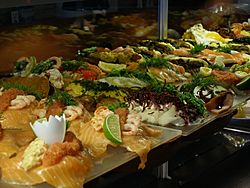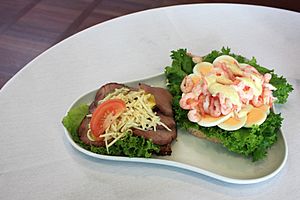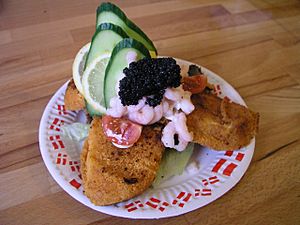Smørrebrød facts for kids

|
|
| Type | Open sandwich |
|---|---|
| Place of origin | Denmark, Norway |
| Region or state | Northern Europe |
| Main ingredients | Rugbrød, butter, cold cuts, pieces of meat or fish, cheese, spreads, and garnishes. |
Smørrebrød (say it like 'smurr-brod') is a super popular open-faced sandwich from Denmark, Norway, and Sweden. The name means "butter and bread" in Danish! It's usually made with a slice of buttered rye bread (called rugbrød), which is a dark, heavy bread. On top, you'll find all sorts of tasty things like cold meats, fish, cheese, or spreads, plus fun garnishes. It's a big part of Scandinavian food!
Contents
What is Smørrebrød?
Smørrebrød is more than just a sandwich; it's like a mini meal on a single slice of bread. Unlike regular sandwiches, it doesn't have a top slice of bread. This lets you see all the yummy ingredients piled high! It's a traditional dish that people in Northern Europe have enjoyed for a long time.
The Bread Base
The bread is super important for Smørrebrød. Most of the time, it's made with rugbrød, which is a special kind of sourdough rye bread.
- It's dark and heavy.
- It's often bought already sliced.
- You can find it in different shades, from light to very dark.
- It can be smooth or have whole grains.
Sometimes, people use franskbrød ('French bread') for certain toppings. This is a lighter, crispy wheat bread. The bread is almost always buttered. For some types, a spread made from lard is used instead.
Delicious Toppings
The best part about Smørrebrød is the huge variety of toppings! You can mix and match almost anything.
Popular Choices
Some classic toppings include:
- Pickled herring: This can be plain, spiced, or curried.
- Thinly sliced cheese: Many different kinds are used.
- Fresh veggies: Sliced cucumber, tomato, and boiled eggs are common.
- Pork liver-paste: A creamy spread made from pork liver.
- Cured or processed meats: Lots of different types, sliced thin.
- Smoked fish: Like salmon or mackerel in tomato sauce.
- Pickled cucumbers and red onion rings.
Often, a creamy sauce like mayonnaise or remoulade is added on top. Sometimes, a mix of mayonnaise with peas, asparagus, and carrots, called italiensk salat ('Italian salad'), is used. You usually eat Smørrebrød with a knife and fork because the toppings are piled so high!
How to Serve Smørrebrød
When you have a Smørrebrød meal, it's common to pass around the sliced bread first. Then, each dish of toppings is passed around, and everyone helps themselves to what they like.
Special Occasion Toppings
For bigger meals or celebrations, Smørrebrød might be served in "courses":
- First, fish toppings like herring, shrimp, or smoked salmon.
- Next, cold meats and salads.
- Finally, cheese with bread or crackers and fruit.
Warm dishes are also often served with the meats on special days. These might include:
- Breaded plaice filet (a type of fish).
- Fried medister sausage.
- frikadeller (Danish meatballs) with pickled red cabbage.
- mørbradbøf (pork tenderloin with onions or mushroom sauce).
Toppings can also change with the seasons. For example, around Easter or Christmas, you might find head cheese or æbleflæsk (roast pork or bacon with apple sauce). In summer, lighter options are popular, like smoked mackerel, sommersalat (radish and cucumber in a smoked cheese dressing), new potatoes, and fresh shrimp.
Popular Smørrebrød Combinations
There are hundreds of ways to make Smørrebrød! Here are some traditional and well-loved examples:
- Dyrlægens natmad ('veterinarian's midnight snack'): Dark rye bread with liver pâté, salt beef, and meat aspic. It's topped with raw onion rings and garden cress.
- Eel: Smoked eel on dark rye bread, with scrambled eggs and sliced radishes or chopped chives.
- Leverpostej: Warm liver pâté on dark rye bread, topped with bacon and sautéed mushrooms.
- Roast beef: Thinly sliced roast beef on dark rye bread, with remoulade, shredded horseradish, and toasted onion.
- Eggs and prawns: Thin slices of egg and prawns on rye or white bread, topped with tomato, mayonnaise, and lemon, with garden cress.
- Roast pork: Thinly sliced roast pork on dark rye bread, with red sweet and sour cabbage, thin pickles, and an orange slice.
- Salmon: Slices of cold-smoked salmon or gravlax (cured salmon) on white bread, with shrimp, a lemon slice, and fresh dill.
- Spiced meat roll: Thinly sliced cold meat, with a thick slice of sky (a clear jelly), raw onion rings, and garden cress.
- Stjerneskud ("shooting star"): Buttered white bread with two kinds of fish – steamed white fish and fried, battered plaice. It's piled high with shrimp, mayonnaise, red caviar, and a lemon slice.
- Tartar: Raw lean beef mince with salt and pepper on dark rye bread, topped with raw onion rings, grated horseradish, and a raw egg yolk.
Smørrebrød in Poems
A Dano-Norwegian poet named Johan Herman Wessel (who lived from 1742 to 1785) even wrote a famous poem about Smørrebrød! Here's a part of it:
At Smørrebrød er ikke Mad,
Og Kærlighed er ikke Had,
Det er for Tiden hvad jeg veed
Om Smørrebrød og Kærlighed.
That Smørrebrød is not food,
and love is not hate,
that is so far all I know
about Smørrebrød and love.
Images for kids
See also
 In Spanish: Smørrebrød para niños
In Spanish: Smørrebrød para niños






